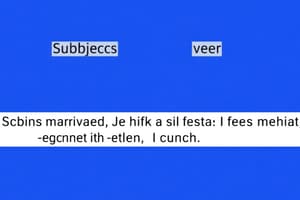Podcast
Questions and Answers
What is the most common sentence structure in English?
What is the most common sentence structure in English?
- Subject + Object + Verb
- Subject + Verb + Object (correct)
- Verb + Subject + Object
- Object + Subject + Verb
Which of the following forms is NOT a part of the verb 'to be'?
Which of the following forms is NOT a part of the verb 'to be'?
- is
- have (correct)
- were
- am
How is the negative form of 'they are' correctly expressed?
How is the negative form of 'they are' correctly expressed?
- They don’t are
- They is not
- They are no
- They are not (correct)
Which aspect of tense is correctly associated with the verb 'to be' in the sentence, 'She is running'?
Which aspect of tense is correctly associated with the verb 'to be' in the sentence, 'She is running'?
What is the correct interrogative form of 'He is there'?
What is the correct interrogative form of 'He is there'?
Which of the following sentences uses the verb 'to be' as a linking verb?
Which of the following sentences uses the verb 'to be' as a linking verb?
Flashcards are hidden until you start studying
Study Notes
Grammar
- Definition: The set of structural rules that govern the composition of clauses, phrases, and words in any given language.
- Components:
- Parts of Speech: Nouns, pronouns, verbs, adjectives, adverbs, prepositions, conjunctions, interjections.
- Sentence Structure: Subject + Verb + Object (SVO) is the most common structure in English.
- Tenses: Present, past, future; each has simple, continuous, perfect, and perfect continuous aspects.
- Punctuation: Rules for using commas, periods, question marks, quotation marks, etc.
Verb "to be"
- Forms: am, is, are, was, were, be, being, been.
- Usage:
- Linking Verb: Connects the subject to a subject complement (e.g., The sky is blue).
- Auxiliary Verb: Used in forming continuous tenses and passive voice (e.g., She is running; The book was written by her).
- Conjugation:
- Present:
- I am
- You are
- He/She/It is
- We are
- They are
- Past:
- I was
- You were
- He/She/It was
- We were
- They were
- Present:
- Negative Form: Add "not" after the verb (e.g., I am not; They are not).
- Interrogative Form: Invert the subject and verb (e.g., Are you ready? Was she there?).
- Common Expressions:
- "There is/are" to indicate existence (e.g., There is a book on the table).
- "To be" in idiomatic expressions (e.g., to be on time, to be in trouble).
Grammar
- Definition: Structural rules governing the arrangement of clauses, phrases, and words in a language.
- Components:
- Parts of Speech: Fundamental elements include nouns, pronouns, verbs, adjectives, adverbs, prepositions, conjunctions, and interjections.
- Sentence Structure: The typical English order is Subject + Verb + Object (SVO).
- Tenses: Three primary tenses (present, past, future) each contain four aspects: simple, continuous, perfect, and perfect continuous.
- Punctuation: Guidelines for the correct use of symbols such as commas, periods, question marks, and quotation marks.
Verb "to be"
- Forms: Includes variations such as am, is, are, was, were, be, being, and been.
- Usage:
- Linking Verb: Serves to connect the subject to a complement (e.g., "The sky is blue").
- Auxiliary Verb: Assists in forming continuous tenses and passive constructions (e.g., "She is running"; "The book was written by her").
- Conjugation:
- Present Tense:
- I am
- You are
- He/She/It is
- We are
- They are
- Past Tense:
- I was
- You were
- He/She/It was
- We were
- They were
- Present Tense:
- Negative Form: Constructed by adding "not" after the verb (e.g., "I am not"; "They are not").
- Interrogative Form: Formed by inverting the subject and the verb (e.g., "Are you ready?"; "Was she there?").
- Common Expressions:
- "There is/are" used to express existence (e.g., "There is a book on the table").
- Used in idiomatic expressions such as "to be on time" or "to be in trouble".
Studying That Suits You
Use AI to generate personalized quizzes and flashcards to suit your learning preferences.




